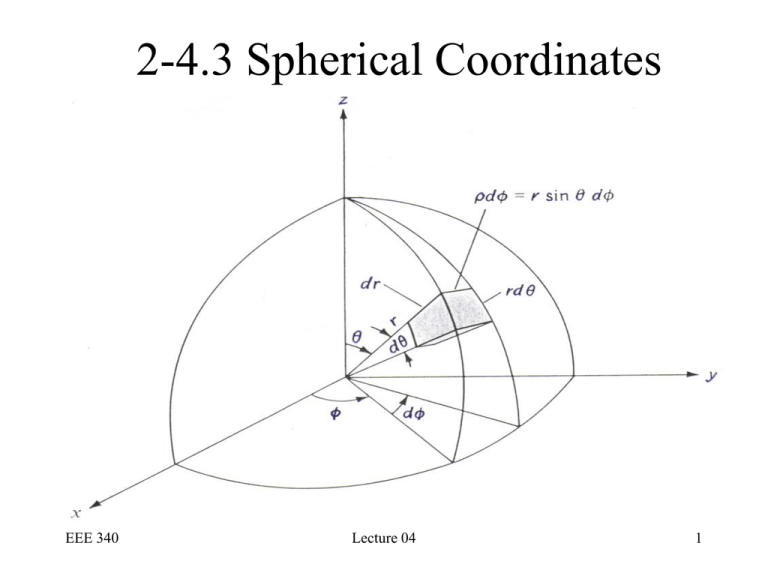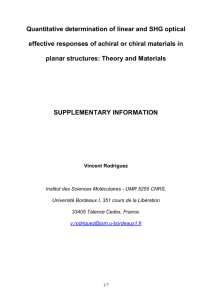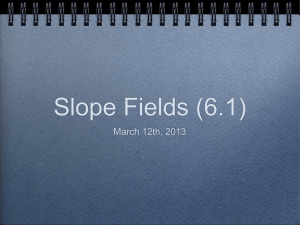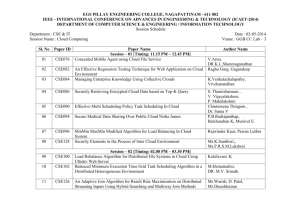Lecture 03
advertisement

2-4.3 Spherical Coordinates EEE 340 Lecture 04 1 • A vector in spherical coordinates A aR AR a A a A (2 65) • The local base vectors from a right –handed system a R a a , a a a R , a a R a EEE 340 Lecture 04 (2 64a) (2 64b) (2 64c) 2 The differential length dl aRdR a Rd a R sind (2 66) The differential areas are 2 dsR R sin dd ds R sin dRd (2 67) ds RdRd The differential volume dv R sindRdd 2 EEE 340 Lecture 04 (2 68) 3 On many occasions the differential areas are vectors dsR R sin d d a R ; ds R sin dR d a ; ds R dR d a 2 EEE 340 Lecture 04 4 Table 2-1 Basic Orthogonal Coordinates (unit) base vectors differential length differential areas differential volum e EEE 340 Cartesian a xor( xˆ ) a yor( yˆ ) a zor( zˆ ) dl xˆdx yˆ dy zˆdz Cylindrical aror(a , ˆ , rˆ) a or(ˆ) a zor( zˆ ) dl rˆdr ˆrd (2 44) zˆdz Spherical aRor( Rˆ ) a or(ˆ) a or(ˆ) dl Rˆ dR ˆRd (2 52) ˆR sin d (2 65) (2 45) (2 53) (2 67) dv dxdydz dv rdrddz dv R 2 sin dRdd (2 46) (2 54) Lecture 04 (2 68) 5 Cartesian coordinates d dx a x dy a y dz az dS dy dz a x dx dz a y dx dy a z dv dx dy dz Differential displacement Differential normal area Differential volume d and dS are vectors. dv is a scalar. EEE 340 Lecture 04 6 dS dx dy az dS az • The differential surface element dS may be defined as dS dS an • we need to remember only d ! EEE 340 Lecture 04 7 Cylindrical coordinates dS r d dz ar ; dr dz a ; r d dr a z d dr ar r d a dz a z dv d d dz rdrddz EEE 340 Lecture 04 Differential displacement Differential normal area Differential volume 8 Coordinate transforms Example 2-11. Convert a vector in spherical coordinates (SPC) A aR AR a A a A into the Cartesian coordinates (CRT). Solution. The general form of a vector in the CRT is A ax Ax ay Ay az Az We need Ax A a x In fact A A a a A a a A a a x R R x x x EEE 340 Lecture 04 9 aR a x sin cos x y 2 2 x y z 2 2 2 x y 2 2 (2 72) x x y z 2 x 2 2 The other eight dot-products can be worked out. A faster and better way to represent the transformation is based on the del operator. EEE 340 Lecture 04 10 Example 2-12 Sphare chell ra=2 cm rb=5 cm The charge density 3 108 2 v cos 4 R C m2 Find the total charge Q EEE 340 Lecture 04 11 Q ρdv • Solution: 2π π rb dφdθdrr 2 sinθρ 0 0 ra 2 rb 1 Q 3 10 cos d sin d 2 dr r 0 0 ra 8 2 3 10 π 2 30 8 1.8π 106 C EEE 340 Lecture 04 12 2-5 Integrals Containing Vector Functions . Lin e in t egral Vect o r Surface in t egral Scalar Vo lum e in t egral VF d v CV dl CF dl S A ds EEE 340 ( 2 78) ( 2 79) ( 2 80) ( 2 81) Lecture 04 13 The line integral around a close path C is denoted as Vd l C In the Cartesian coordinates (CRT) Vdl C V ( x, y, z )ax dx a y dy az dz a x C V ( x, y, z )dx a y C V ( x, y, z )dy az C V ( x, y, z )dz EEE 340 Lecture 04 (2 82) (2 83) 14 P r dr • Example 2-13 2 O • a) along the straight line OP, where P(1,1,0) y P(1,1,0) P1 0 EEE 340 P2 Lecture 04 x 15 b). Along path OP1P Solution. Using (2-52) of cylindrical a). P 2 2 2 O r dr ar O ar r dr 2 3 3 2 2 (a x cos45 a y sin 45) 3 2 (a x a y ) 3 EEE 340 Lecture 04 16











